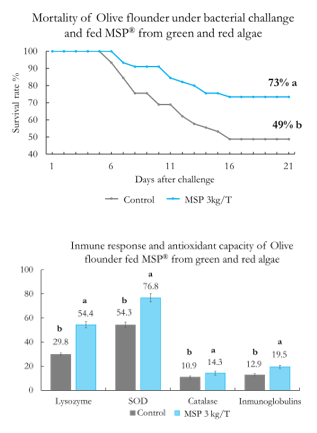MACROALGAL SULPHATED POLYSACCHARIDES MODULATE IMMUNE RESPONSE AND IMPROVE PATHOGEN RESISTANCE IN OLIVE FLOUNDER
The cell wall of green and red marine algae is mainly composed of water-soluble sulfated polysaccharides with several biological activities, such as immunomodulation and strengthening of the intestinal barrier components respectively. Olmix has been able to isolate, identify and concentrate different macroalgal sulfated polysaccharides which are naturally available in the coast of Brittany (France) being it one of the most important sustainable macroalgae resources in the world. Macroalgal extracts are potentially useful in aquaculture to modulate immune response and to enhance epithelial cells integrity in the gills, skin and gut which are most important lymphoid tissue form the barrier to pathogens in fish (GIALT, SALT and GALT). The study aimed to evaluate the effects of macroalgal sulfated polysaccharides o n the health of olive flounder under bacterial challenge. The study was carried out at the Jeju University (South Korea) in a recirculating system for 15 weeks (105 days). Juveniles of Paralichthys olivaceus , initial weight 26.51g ±0.02 g , were assigned to 2 treatments with 4 replicates (40 fish/3 00L tank), totalizing 320 fish. Two iso-nutritive diets, Control and MSP® (commercial product based on the combination of green and red algal extracts) , were formulated to differ only on the inclusion of 0.3% of green and red macroalgal polysaccharides at the MSP® group. Fish were fed twice a day ad libitum. Results were compared using ANOVA and Student test, p<0.05).
At week 12, fish 44/treatment were intraperitoneally infected with Edwardsiella tarda (1 x 105 CFU/fish) and mortality was recorded for 21 days. Additionally, b lood samples were collected from 12 fish/treatment at the week 12 before challenge for immune assay and antioxidant capacity. Lysozyme activity was quantified by turbidi metric method using Micrococcus lysodeikticus. Superoxide dismutase (SOD) and catalase activities were assessed by commercial kit s, Sigma Aldrich and Biovision, respectively. Total immunoglobulin was quantified using micro-protein determination method. Lysozyme activity and total immunoglobulins were greater in MSP group by 45% and 34%, respectively. Likewise, SOD and catalase activities were increased by 29% and 24% by MSP®. M ortality rate was 33 % lower in fed the MSP® ( 49% vs 73%). The use of MSP® improved the immunity, antioxidant capacity and pathogen resistance in olive flounder.
